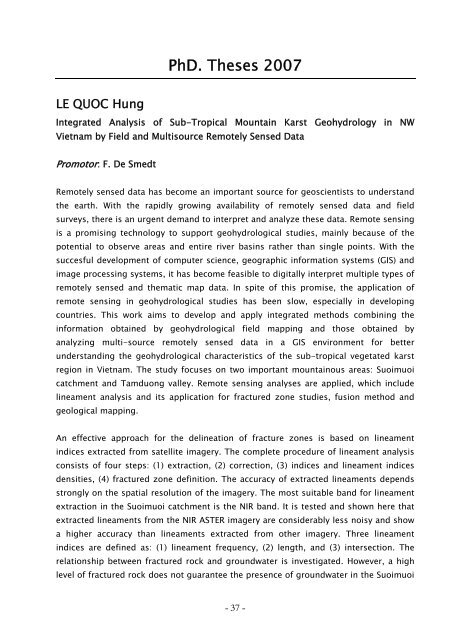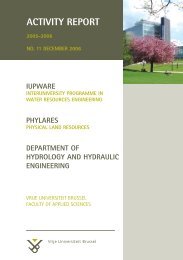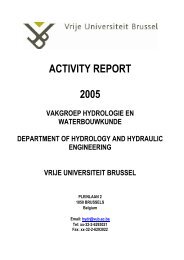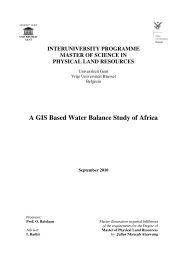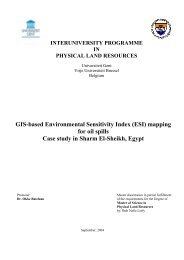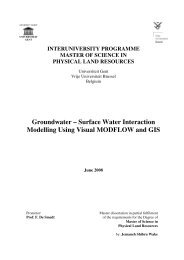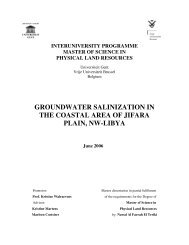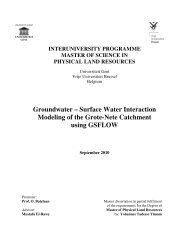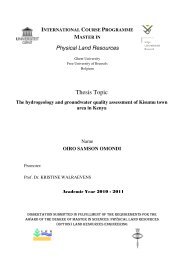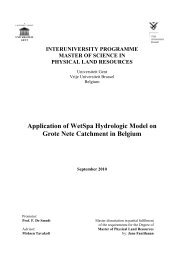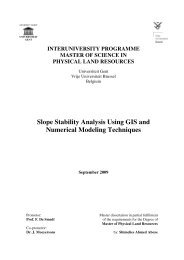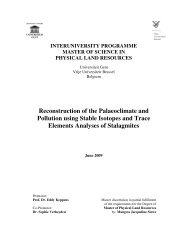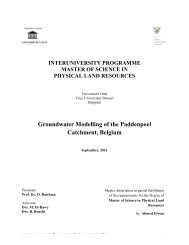C O N T E N T S - Physical Land Resources - Vrije Universiteit Brussel
C O N T E N T S - Physical Land Resources - Vrije Universiteit Brussel
C O N T E N T S - Physical Land Resources - Vrije Universiteit Brussel
Create successful ePaper yourself
Turn your PDF publications into a flip-book with our unique Google optimized e-Paper software.
PhD. Theses 2007LE QUOC HungIntegrated Analysis of Sub-Tropical Mountain Karst Geohydrology in NWVietnam by Field and Multisource Remotely Sensed DataPromotor: F. De SmedtRemotely sensed data has become an important source for geoscientists to understandthe earth. With the rapidly growing availability of remotely sensed data and fieldsurveys, there is an urgent demand to interpret and analyze these data. Remote sensingis a promising technology to support geohydrological studies, mainly because of thepotential to observe areas and entire river basins rather than single points. With thesuccesful development of computer science, geographic information systems (GIS) andimage processing systems, it has become feasible to digitally interpret multiple types ofremotely sensed and thematic map data. In spite of this promise, the application ofremote sensing in geohydrological studies has been slow, especially in developingcountries. This work aims to develop and apply integrated methods combining theinformation obtained by geohydrological field mapping and those obtained byanalyzing multi-source remotely sensed data in a GIS environment for betterunderstanding the geohydrological characteristics of the sub-tropical vegetated karstregion in Vietnam. The study focuses on two important mountainous areas: Suoimuoicatchment and Tamduong valley. Remote sensing analyses are applied, which includelineament analysis and its application for fractured zone studies, fusion method andgeological mapping.An effective approach for the delineation of fracture zones is based on lineamentindices extracted from satellite imagery. The complete procedure of lineament analysisconsists of four steps: (1) extraction, (2) correction, (3) indices and lineament indicesdensities, (4) fractured zone definition. The accuracy of extracted lineaments dependsstrongly on the spatial resolution of the imagery. The most suitable band for lineamentextraction in the Suoimuoi catchment is the NIR band. It is tested and shown here thatextracted lineaments from the NIR ASTER imagery are considerably less noisy and showa higher accuracy than lineaments extracted from other imagery. Three lineamentindices are defined as: (1) lineament frequency, (2) length, and (3) intersection. Therelationship between fractured rock and groundwater is investigated. However, a highlevel of fractured rock does not guarantee the presence of groundwater in the Suoimuoi- 37 -


